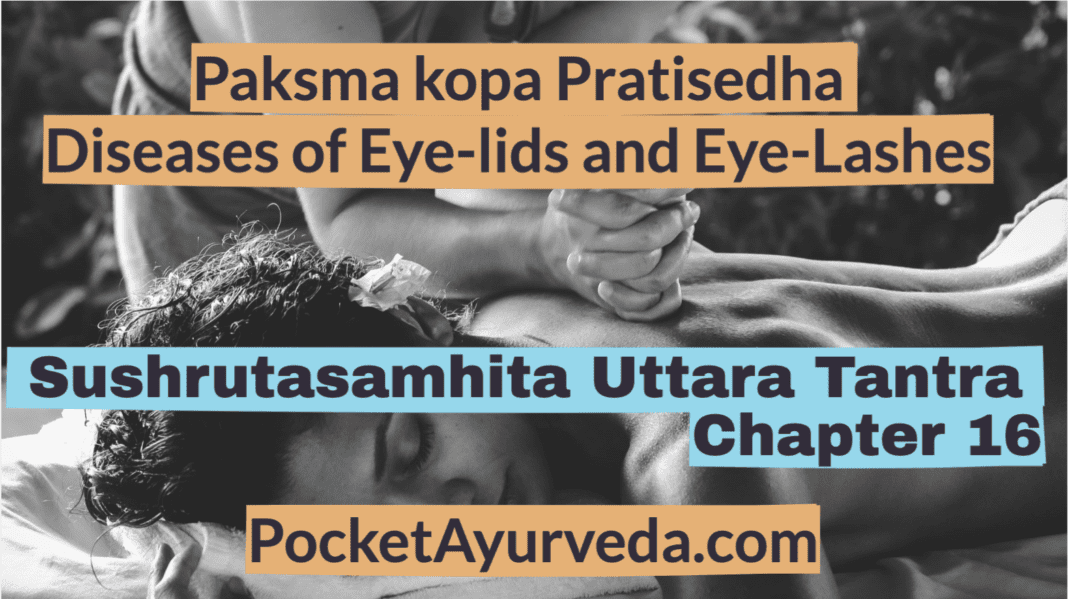षोडशोऽध्यायः अथातः पक्ष्मकोपप्रतिषेधं व्याख्यास्यामः, भगवान् धन्वन्तरिः ॥ १ ॥ यथोवाच
Now we shall discourse on the curative measures for the remedy of diseases occurring on the eye-lashes and hence on the eye-lid (Paksma-kopa Pratisedha) 1
याप्यस्तु यो वर्त्मभवो विकारः पक्ष्मप्रकोपोऽभिहितः पुरस्तात् । तत्रोपविष्टस्य नरस्य चर्म वर्मोपरिष्टादनु पक्ष्माश्रितञ्चैकमतोऽवकृन्तेत् । तिर्यगेव ॥ २ ॥ भ्रुवोरधस्तात् परिमुच्य भागौ कनीनकापाङ्गसमं समन्ताद् यवाकृति स्निग्धतनोर्नरस्य ॥ ३ ॥ उत्कृत्य शस्त्रेण यवप्रमाणं बालेन सीव्येद् भिषगप्रमत्तः । दत्त्वा च सर्पिर्मधुनाऽवशेषं कुर्याद् विधानं विहितं व्रणे यत् ॥ ४ ॥ ललाटदेशे च निबद्धपट्ट प्राक्स्यूतमत्राप्यरञ्च बद्ध्वा । स्थैर्यं गते चाप्यथ शस्त्रमार्गे बालान् विमुञ्चेत् कुशलोऽभिवीक्ष्य ॥ ५ ॥
Surgical Treatment- In case of Paksma-kopa which is an affection of the eye-lid and which has been described before as admitting only of palliative treatment, the patient should be first treated with a Sneha and made to take his seat (in a proper position). A cut in the shape and size of a barley corn should be made in the eye-lid horizontally parallel to (the part of the eye-ball lying between) the Kaninaka (pupil) and the Apanga ( exterior corner of the eye) leaving two parts below the eye-brow and one part above the eye-lashes. The surgeon should then diligently suture up the two edges of the incisions with (horse’s) hair. After the application of honey and clarified butter to the operated part, it should be treated in the manner of an (incidental) ulcer. A piece of linen should be tied round the forehead and the horse’s hair sewing up the operated part should be attached thereto. The stitching hair should be carefully removed after the complete adhesion¹ of the two edges of the incidental ulcer. 2-5.
एवं च चेच्छाम्यति तस्य वर्त्म निर्भुज्य दोषोपहतां बलिञ्च । ततोऽग्निना वा प्रतिसारयेत् तां क्षारेण वा सम्यगवेक्ष्य धीरः ॥ ६ ॥ छित्त्वा समं वाऽप्युपपक्ष्ममालां सम्यग्गृहीत्वा बडिशैस्त्रिभिश्च । पथ्याफलेन प्रतिसारयेत् तु घृष्टेन वा तौवरकेण सम्यक् ॥ ७ ॥ चत्वार एते विधयो विहन्तुं पक्ष्मोपरोधं पृथगेव शस्ताः । विरेचनाश्च्योतननस्यधूम-लेपाञ्जनस्त्रेहरसक्रियाश्च ॥८॥
Cauterisation – In case of the failure of the preceding measure, the eye-lid should be carefully examined and lifted up in an inverted posture and the diseased cyst (Bali) should be very carefully cauterised with fire or alkali. As an alternative, the Paksmamala (eye-lashes) should be all removed and the affected eye-lid having been carefully secured with three hooks (Badisa) should be rubbed with pasted Haritaki and Tuvaraka (Lodhra). The four aforesaid measures² as well as purgatives, eye-drops (Ascyotana), medicinal snuffs, inhalations (fumigations) Plasters, Collyrium, Sneha and Rasa-kriya, should be likewise held as beneficial 3 in cases of Paksma-kopa. 6-8.
इति सुश्रुत संहितायामुत्तरतन्त्रे पक्ष्मकोप-प्रतिषेधो नाम षोडशोऽध्यायः ॥ १६ ॥
Thus ends the sisteenth chapter of the Uttara-Tantra in the Susruta Samhita which treats of the remedies of Paksma-kopa.
1. According to Vagbhata, the stitching hair should be removed on the fifth day. 2. The four measures are (a) operation, (b) cauterisation with fire, (c) cauterisation with alkali, and (d) application of medicinal drugs. 3. It should be noted that this disease cannot be radically cured, but is amenable only to palliative treatments ( याप्य).




